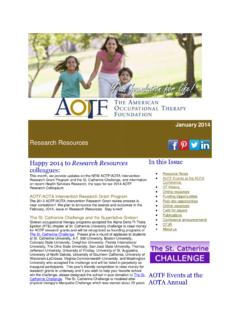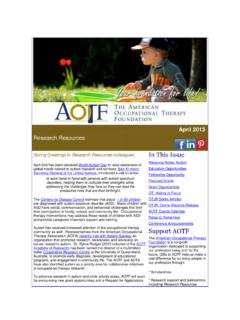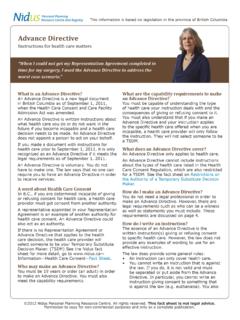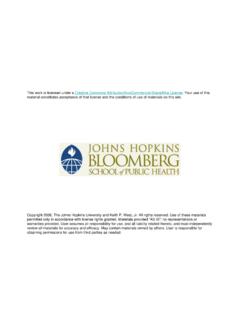Transcription of November 2010 Research Resources - AOTF
1 Dear C This mstrives it impliethat paof grou Groupsresearcan intework ovisit hisinterve Finally,Facebogive usyour pa Cordia CharlesExecutInterim WilmaThe ReIn this how sopractitioand paAOTC olleagues, onth's Reseato enable paes more than articipation haups. s are essentiach being donernist and medn how social s web page. Cntion, that is, , since I am oook page. If ys a show of suarticipation in lly, s Christiansetive Director m Director, Insa L. West Lelationship bmonth's letterocial networksoners, too, ararticipation. TRATF Institutarch Resourcerticipation by simply actives a social comally social nete in the area dical sociolognetworks influChristakis' findthe role of thon the topic ofyou are part oupport.
2 As alwFoundation a n titute for the S Library Resbetween Socr, Dr. Christias influence oure aware of thThey have conResearcA monthly te for the SNovees is devoted the people it e engagemenmponent--thatworks. Latelyof social netwgist at Harvarduence have imhe profession f social netwof that networkways, we appactivities! Study of Occusource Noial Support oansen cites Niur lives (Chrishe importancenducted studich Resou newsletteStudy of Ocember 201to participatioserves. Whant. Because pet is, to live fuly, there is a grworks. For exad Medical Sch. For a taste, mplications foin influencingorking, forgivek, we'd be horeciate your supation and Hotes or a Social Ncholas Christtakis & Fowlee of a client's es with populurces r of the ccupation a0 on.)
3 As a profet is participatieople are soclly, people mureat deal of oample, the school, has dontake a momer population-bg public healthe me for mentnored if you wsupport and wHealth Network and takis, MD, Pher, 2009). Ocsocial relationlations of diffeand Healthession, occupion? Some wocial beings, thust participateoutstanding hecientist Nichole some very ent to view hisbased occupah. tioning that AOwould stop bywelcome yourParticipationD, MPH and ccupational thnships to his erent ages an pational theraould argue thhis suggests e as membersealth-related as Christakisprovocative s TED lectureational therapOTF now hasy our page anr comments an his work on erapy or her activitind diagnoses apy at s s, or py s a d and es to uncover the impact of the presence of a social network on participation in activities of daily living and in social engagements (Price, Stephensen, Krants, Ward, In Press; Cosbey, Johnston & Dunn, 2010; Krupa, Woodside & Pocock, 2010; Eklund, 2006).
4 Benefits from this connection between social networking or engagement and participation in activities go both ways. Bertera suggests in a 2003 study that social networks might encourage older adults to participate in physical activities. Gunilla, Lexell and Sk r (2007) identified social support as a motivator and enabler for thirteen women with spinal cord injuries to participate in occupations. For individuals with a disability, particularly children or adolescents, finding friends within their larger social network can be a challenge (Morrison & Burgman, 2009). Richardson (2002) investigated how the school environment supported or inhibited children's socialization.
5 For teens with physical disabilities, the successful development of friendships is complex and influenced by personal, environmental, interactional, and relationship factors (Jamieson, et al., 2009, p. 368). A successful bonding experience for adolescents with chronic rheumatic disease through a short residential program, called 'Independence Break.' is described in a 2005 article by Hackett, et al. The references cited here are just a small sampling of the literature on this topic that can be found through OT SEARCH. Bertera, EM. (2003).Physical activity and social network contacts in community dwelling older adults. Activities, Adaptations and Aging, 27(3/4), 19-27.
6 Christakis, NA & Fowler, JH. (2009). Connected: The surprising power of our social networks and how they shape our lives. New York: Little, Brown and Company. Cosbey, J, Johnston, SS & Dunn, ML. (2010). Sensory processing disorders and social participation. The American Journal of Occupational Therapy, 64, 462-473. Eklund, M. (2006). Occupational factors and characteristics of the social network in people with persistent mental illness. The American Journal of Occupational Therapy, 60, 587-594. Gunilla, I, Lexell, J & Sk r, L. (2007). Social support provides motivation and ability to participate in occupation. OTJR: Occupation, Participation and Health, 27, 23-30.
7 Hackett, J, Johnson, B, Shaw, KL & McDonagh, JE. (2005). Friends united: an evaluation of an innovative residential self-management programme in adolescent rheumatology. The British Journal of Occupational Therapy, 68, 567-573, Jamieson, Hutchinson, NL, M, Taylor, J, Westlake, KP, Berg, D & Boyce, W. (2009). Friendships of adolescents with physical disabilities attending inclusive high schools. Canadian Journal of Occupational Therapy, 76, 368-375. Krupa, T, Woodside, H & Pocock, K. (2010). Activity and social participation in the period following a first episode of psychosis and implications for occupational therapy. The British Journal of Occupational Therapy, 73, 13-20.
8 Morrison, R & Burgman, I. (2009). Friendship experiences among children with disabilities who attend mainstream Australian schools. Canadian Journal of Occupational Therapy, 76, 145-152. Price, P, Stephensen, S, Krants, L & Ward, K. (In Press). Beyond my front door: the occupational and social participation of adults with spinal cord injury. OTJR: Occupation, Participation and Health. Richardson, PK. (2002).The school as social context: social interaction patterns of children with physical disabilities. The American Journal of Occupational Therapy, 56, 297-304. In This Issue Wilma L. West Library resource Notes OTJR - Online Advanced Release Education Opportunities Donate Notice of ADA Hearings Conference Announcements Web Resources Publications Image of the Month OTJR: Occupation, Participation and Health Online Advanced Release OTJR: Occupation, Participation and Health, published quarterly by the American Occupational Therapy Foundation, Inc.
9 , offers original Research articles of professional interest to the practicing occupational therapist with a focus on occupation and fostering interdisciplinary Research . Visit: OTJR Online. Articles appearing in this "Online Notice of Public Hearings on ADA Department of Justice Announces Public Hearings on Proposed Revisions to ADA Regulations The Department of Justice has scheduled three public hearings on its regulatory proposals concerning the Americans with Disabilities Act (ADA). These proposals, or Advance Notices of Proposed Rulemaking (ANPRMs), seek public comment on the possibility of revising the ADA regulations to address accessible web information and services, movie captioning and video description, accessibility of Next Generation 9-1-1, and accessible equipment and furniture.
10 The public hearings are scheduled for the following dates: Nov. 18, 2010, Dec. 16, 2010, and Jan. 10, 2011. Additional information is available on the ADA Home Page and the ANPRMs are also available electronically in accessible formats online. Conference Announcements Festival of International Conferences on Caregiving, Disability, Aging and Technology - FICCDAT 2011 (June 5-8, 2011, Toronto, Ontario) FICCDAT 2011 is six conferences in one: Growing Older With A Disability; RESNA/ICTA (the Rehabilitation Engineering and Assistive Technology Society of North America and the International Conference on Technology and Aging) Advancing Rehabilitation Technologies for an Aging Society Conference; Advances in Neurorehabilitation; Caregiving in the 21st Century; the 34th Canadian Medical and Biological Engineering Conference.






